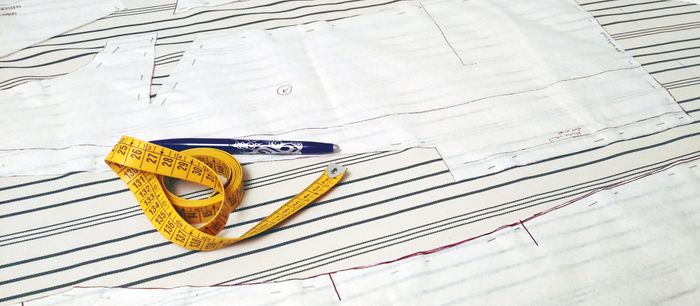Learn How to Sew a Tab-Front Opening or a Mitered Side Vent
Enhance basic tops with a tab-front or side-seam opening
Your favorite top or blouse pattern is the ideal starting point for a fresh redesign. Keep the basic silhouette and fit, and revise the closures, collars, cuffs, or hemline—any of these elements can give it a new look.
Consider two details that provide style and functionality: The first is a beautifully engineered tab-front opening that can be casual or sophisticated, depending on the fabric and closures you use. Replace a full button-front opening with this, or add the tab neckline to a pullover top. The second adaptation is a lapped, mitered side vent. This feature is subtle and elegant. Because the opening edges overlap, you can create a deeper vent that allows the blouse fabric to move without revealing too much skin. Once you learn the technique, consider trying it at the side hem of a skirt or pants.
These details are shown on two of my designs, but you can easily apply them to other patterns. Expand your wardrobe creatively without starting from scratch for each new garment.
A tab-front opening
A tab-front shirt has a front placket that extends only partway down the shirt front, similar to the opening on a polo shirt. You can start with a button-front shirt pattern or with a pullover top. Add buttons, topstitching, or other embellishment to personalize your top.
Prepare the pattern
1. Draft the tab pattern. Work on graph paper with a 1⁄8-inch grid for the greatest precision. Draw a line the length of the desired finished placket, plus 3 inches. For a placket that finishes at 1-3⁄8 inches wide, draw lines at the intervals shown in the diagram. Draw a straight line across the top and bottom; the neckline curve will be established later. Label the lines, and mark the opening’s bottom end 1 inch above the lower line.
2. Cut the tab. Cut one of fashion fabric, and transfer the pattern lines to the wrong side. Staystitch at the outer lines 3⁄8 inch from the long cut edges. Using a template as a guide, press under the long edges along this line.
Attach the tab
1. Establish the garment’s center front. If the pattern has no front opening, mark the center front on the garment’s wrong side. If the pattern has a front opening, fold back any extensions or facings at the center front and mark this line “Place on fold.”
2. Cut the front. Place the center-front line on the fabric fold and cut. Mark the center-front line on the right side with removable marker, chalk, or hand basting.
3. Pin the tab in place. With right sides together, place the tab on the garment front, aligning the tab’s center-front line on the garment center front. Let the tab extend above the garment neckline edge slightly, to be trimmed later.
4. Sew the placket opening edges. Set the stitch length to 2.0 mm and stitch 1⁄8 inch from the slash line, from neck to base. At 1⁄2 inch from the bottom, shorten the stitch length to 1.0 mm or 1.5 mm. At the bottom, pivot with the needle down and sew one or two stitches across the bottom. Pivot again and sew up the opposite side of the slash line, 1
⁄8 inch away. Sew for 1⁄2 inch, then lengthen the stitch length to 2.0 mm.
5. Slash the opening. Cut carefully along the slash line, all the way to the tip.
Complete the installation
1. Press and turn the tab. Press it to the left and the right to establish foldlines along the opening edge. Then turn the tab layer to the garment wrong side. The narrower edge faces the overlap side; the wider edge forms the underlap.
2. Press the tab creases. Press the wider underlap edge along its remaining foldline, so the first fold aligns with the slash stitching. Verify that all the slash seam allowances are enclosed within the tab folds, and press the tab layers. Secure the folds with Lite Steam-A-Seam 2.
3. Clean-finish the tab bottom. Serge across the raw edges or, if preferred, finish with a low-bulk binding.
4. Edgestitch the overlap side. From the garment wrong side, edgestitch along the tab’s fold edge. Leave long thread tails. Pull them to the wrong side and tie.
5. Edgestitch the underlap side. From the right side, edgestitch on the tab side of the slash seamline, to anchor the tab’s folded edge. Sew from the neckline to the bottom of the opening and backstitch.
6. Topstitch the tab bottom. Press the tab over- and underlap into position and pin. From the right side, sew a rectangle across the tab bottom. Pull the thread tails to the wrong side and tie.
7. Trim the neckline. Cut off the excess tab fabric extending beyond the neckline edge.
A mitered lapped vent
This attractive vent moves as you do but stays closed when you stand still. It starts with a pattern in which the edges are cut to make mitering easy and precise. This technique yields a vent with a 1-3⁄8-inch-wide facing and equally wide hem allowances. Adjust the vent length and allowances as desired; be sure allowances on the adjacent edges are equal in width.
1. Trace the front and back patterns. Draw the side seamlines 5⁄8 inch from the cutting line, mark the hem foldline, and place a dot at the top of the vent opening. Adjust the hem allowance to 1-3⁄8 inches wide.
2. Add a front extension. Draw a line 1-3⁄8 inches outside the original side seamline, from 1 inch above the vent top to the new hem cutting line. At the level of the vent top, draw a diagonal line from the vent edge to the side seam cutting line.
3. Draft the mitered corner. At the intersection of the side seamline and hem foldline, draw a line at a 45-degree angle that intersects the vent edge and hem edge. This is the miter seamline. Add a 1⁄4-inch-wide seam allowance outside this line.
4. Add a back extension. Draw a line 1-1⁄8 inches outside the side seamline; label it “Vent foldline.” Draw a second line 1-3⁄8 inches beyond the foldline; this is the vent cutting line.
5. Shape the vent top. Mark the vent foldline at the level of the vent top. Mark the vent cutting line 1 inch above this level. Draw a line to connect these marks. Fold the extension on its foldline, and trace the angle of this diagonal line to the extension just outside the side seam allowance, intersecting the side seam cutting line.
6. Draft the mitered corner. As for the front pattern, draw the angled miter seamline and its 1⁄4-inch-wide seam allowance.
Construct the vent
1. Cut the fabric. Following the new front and back patterns, cut the fabric and transfer the marks to the fabric wrong side. Finish the side and hem edges, but not the diagonal corner, with a three-thread overlock stitch.
2. Miter the corners. On the garment front, align the miter seam with right sides together and sew. Repeat on the garment back. Trim the corner at an angle and press the seam allowances open over a point presser. Turn the corners right side out and press.
3. Sew the side seam. With right sides together, pin, then sew, from the upper bodice down to the vent’s top mark. Backstitch.
4. Press. Clip the back seam allowance at the vent top to release it, and press open the seam allowances above the vent. Press the vent’s folded edges and hem foldline.
5. Edgestitch to finish. Apply a strip of Steam-A-Seam between the vent and garment outer layers and fuse to hold the vent edges in place. Edgestitch the vent and hem edges. At the vent top, sew a triangle to reinforce the opening and keep the seam allowances flat.



















The label is misleading. The correct term for this type of opening is placket opening. Tabs are prepared strips with button or buttonhole similar to epaulettes.